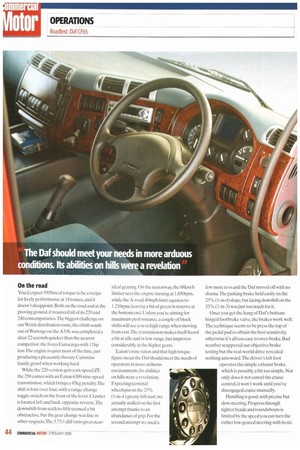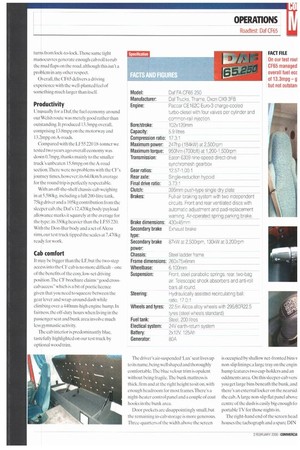THE LITTLE BIG TRUCK
Page 43

Page 44

Page 45

Page 46

If you've noticed an error in this article please click here to report it so we can fix it.
Although it sits alongside its cousin, the LF55, in
the 18-tonne sector, the Daf CF65 claims a niche all of its own. Cohn Barnett puts it to the test.
parent company Paccar may be the last major American-owned truck maker. and Daf may officially be Dutch. but that doesn't stop it being arguably the most British of trucks. Wherever you look in the company the influence of Leyland still shines through. This Britishness was never more obvious than when the UK truck sales figures for 2005 were revealed. Being market leader in every sector is an achievement never before seen in the current scheme of things.
'The public gets what the public wants' could be Dal's motto— it certainly didn't get where it is today without meeting the needs of its market.This week's test subject is a good example. In the 18-tonne sector it offers two distinct product lines. If ultimate payload, urban manoeuvrability and a compact cab are your priorities. you can take the LF55,a big little truck. But if your operations tend more to the long-distance and you can trade a bit of carrying capacity for a bigger cab on an altogether more manly platform, it also offers a little big truck—the CF65, as driven here.
The initial decision to buy a CF65 leads on to a few more. Drivelines are nominally 220hp and ZF six-speed transmission or 250hp and nine-speed Eaton.The 5.9-litre engines are Paccar's version of the six-cylinder European Engine Alliance (or Cummins) unit with four valves per cylinder and common-rail injection.
Three cabs (day, low-roof sleeper and highroof Space Cab). and a dozen wheelbase choices (from 4.000 to 7,300mm) complete the main choices, though there's still an extensive list of optional details to go through.
Our 6,100mm-wheelbase test vehicle came with a 251t Don-Bur Slide-a-Side bodyThis impressive item has metre-long rigid sections front and rear with a folding fabric section in between.With automatic buckleless tensioning it offers the benefits of a curtainsider with the completely flat sides of a conventional box.
Suspension includes a 7,100kg steel parabolic sprung front axle and.on our test truck, a £1.540 air option at the rear. Brakes are 430mm ventilated discs front and rear. backed up by a single-stage exhaust brake.
On the road
You'd expect 950Nm of torque to be a recipe for lively performance at 18 tonnes, and it doesn't disappoint. Both on the road and at the proving ground, it trounced all of its 220 and 240 contemporaries. The biggest challenge on our Welsh distribution route, the climb south out of Wantage on the A338. was completed a clear 22 seconds quicker than the nearest competitor. the Iveco Eurocargo with II hp less.The engine is quiet most of the time,just producing a pleasantly throaty Cummins family growl when working hard.
While the 220 version gets a six-speed ZF, the 250 comes with an Eaton 6309 nine-speed transmission. which brings a 45kg penalty.The shift is four over four, with a range-change toggle switch on the front of the lever. Crawler is located left and back, opposite reverse:111e downshift from sixth to fifth seemed a bit obstructive, but the gear change was fine in other respects.The 3.73:1 diff ratio gives near ideal gearing. On the motorway, the 88km/h limiter sees the engine turning at 1.650rpm. while the A-road 40mph limit equates to 1,210rpm, leaving a bit of green in reserve at the bottom end.lJnIess you're aiming for maximum per-Forman ce, a couple of block shifts will see you in high range when moving from rest.The transmission makes itself heard a bit at idle and in low range, but improves considerably in the higher gears.
Eaton's nine ratios and that high torque figure mean the Daf should meet the needs of operators in more arduous environments. Its abilities on hills were a revelation. Expecting terminal wheelspin on the 25% (1-in-4 ) greasy hill start, we actually stalled on the first attempt thanks to an abundance of grip. For the second attempt we used a few more revs and the Daf moved off with no drama.The parking brake held easily on the 25% (1-in-4) slope, but facing downhill on the 33% (1-in-3) was just too much for it.
Once you get the hang of Dafs bottomhinged footbrake valve, the brakes work well. The technique seems to be press the top of the pedal pad to obtain the best sensitivity, otherwise it's all too easy to over-brake. Bad weather scuppered our objective brake testing hut the real-world drive revealed nothing untoward.The driver's left foot operates the simple exhaust brake, which is possibly a bit too simple. Not only does it not cancel the cruise control, it won't work until you've disengaged cruise manually.
Handling is good, with precise but slow steering. Progress through tighter bends and roundabouts is limited by the speed you can turn the rather low-geared steering with its six
turns from lock-to-lock.Those same tight manoeuvres generate enough cab roll to rub the mud flaps on the road. although this isn't a problem in any other respect.
Overall, the CF65 delivers a driving experience with the well-planted feel of something much larger than itself.
Productivity
Unusually for a Dal, the fuel economy around our Welsh route was merely good rather than outstanding. It produced 13.3mpg overall, comprising 13.8mpg on the motorway and 13.2mpg on A-roads.
Compared with the LE55 220 I 8-tonner we tested two years ago overall economy was down 0.7mpg. thanks mainly to the smaller truck's unbeaten 15.8mpg on the A-road section.There were no problems with the CF's journey limes, however:its 64.0km/h average for the round trip is perfectly respectable. With an off-the-shelf chassis-cab weighing in at 5.580kg, including a full 200-litre tank, 75kg driver and a 105kg contribution from the sleeper cab. the Dais 12.420kg body/payload allowance marks it squarely at the average for the type: its 350kg heavier than the LF55 220. With the Don-Bur body and a set of Alcoa rims, our test truck tipped the scales at 7,470kg ready for work.
Cab comfort
It n1 I■ be bigger than the LF, hut the two-step accc:-. into the CT:cab is no more difficult -one of the benefits of the cosy. low-set driving position.The CF brochure claims 'goodcrosscab accesswhich is a bit of poetic licence given that you need to squeeze between the gear lever and wrap-around dash while climbing over a 440mm-high engine hump. In fairness, the off-duty hours when living in the passenger seat and bunk area involve much less gymnastic activity.
The cab interior is predominantly blue. tastefully highlighted on our test truck by optional wood trim. The driver's air-suspended 'Lux' seat lives up toils name, being well shaped and thoroughly comfortable.The blue velour trim is opulent without being fragile. The hunk mattress is thick,firrn and at the right height to sit On, with enough headroom for most frames.There's a night-heater control panel and a couple of coat hooks in the bunk area.
Door pockets are disappointingly small, but the remaining in-cab storage is more generous, Three-quarters of the width above the screen is occupied by shallow net-fronted bins v non-slip linings; a large tray on the engirt hump features two cup-holders and an oddments area, On this sleeper-cab Niers] you get large bins beneath the bunk, and there's an external locker on the nearsid, the cab. A large non-slip flat panel above centre of the dash is easily big enough fa portable IV for those nights in.
The right-hand end of the screen head houses the tachograph and a spare DIN
housing. together with a solitary switch to cancel the reversing bleeper.The roof hatch is manually opened. Entertainment is courtesy of a VDO radio/single CD.
Visibility is fair, with relatively slim A-pillars. and we didn't had the black secondary door window frame to he a problem.We would appreciate 'one-touch' operation of the electric windows, though.
Electric heated and adjusted main mirrors are a £140 option.The main sun visors arc staggered. but the fold-down visor above the driver's door window could be bigger.There's no excuse for a dirty windscreen, with no less than four washer jets on each wiper blade.
Seven vents delivering face-level air should cover all needs, while the knobs controlling the heater are both chunky and conveniently located.As usual. we weren't allowed to touch the one for the optional air-con.
Most of the frequently used controls (lights, wipers and horn) are on the left column stalk. with cruise control on the right.The column is fully adjustable with an air-operated lock.The instrument panel is Dais usual model of clarity, with dials measuring engine and road speed. fuel.coolant temperature and air.
Everything else is monitored by the equally clear driver information display, operated by a large 'mouse knob on the dash.The large minor rocker switches are easy to find and operate and the whole driving environment is ergonomically sound.•




























































































































































































